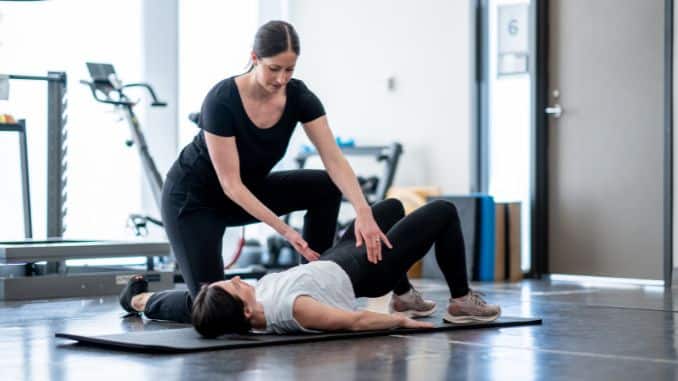
The coccyx is the last bone at the end of the spine. Referred to as the “tailbone,” the coccyx consists of four small fused bones and then can benefit from tailbone pain relief exercises if discomfort arises.
A coccyx fracture is a partial or complete break in this area.
Coccyx fractures usually result from a backward fall or a strong blow to the tailbone.
The coccyx has some flexibility to absorb shock, but excessive stress on the bone can lead to a crack or break.
In addition, performing exercises on the muscles around your tailbone can help reduce your risk of a future injury.
Performing weight-bearing exercises on your tailbone or coccyx fracture can help expedite new bone growth, reducing the time you are injured.
If you’re struggling with tailbone pain [1], you’re not alone.
Whether it’s from a fall, prolonged sitting, poor posture, or even childbirth, this discomfort can make everyday activities unbearable. The good news?
Tailbone pain relief exercises can help relieve tension, strengthen surrounding muscles, and then promote healing. These exercises are specifically designed to reduce tailbone pain.
These are some helpful exercises for tailbone fractures you can do to hasten your healing and then relieve pain after a fracture.
In this guide, you’ll learn the best tailbone pain exercises to ease discomfort, improve mobility, and prevent future pain. Let’s dive in!
In addition to the exercises mentioned earlier, there are several advanced exercises that can help relieve tailbone pain, including:
1. Child’s Pose (Gentle Stretch for the Spine)
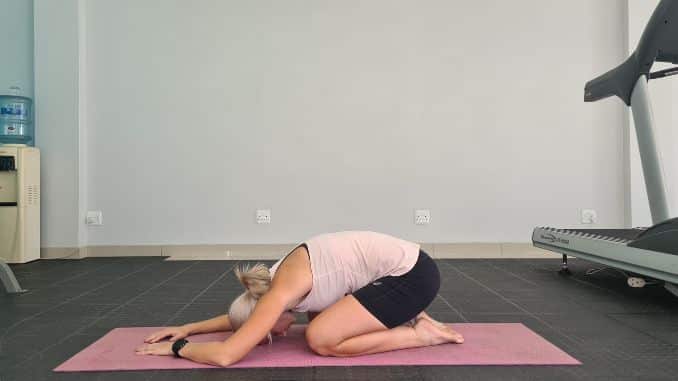
This helps relieve pain by lengthening tight muscles around your tailbone.
- Begin in an upright kneeling position on the floor with your knees closed together, maintaining good alignment with your upper body.
- Tighten your abdominal area, shift your hips back to your feet, and extend your arms in front or place them on the sides.
- Lower your forehead to the floor, relaxing your mid-back area for a light stretch.
- Hold this position for several deep belly breaths, in through your nose and then out through your mouth.
Why it works: Stretches the entire spine and relieves tension in the lower back and tailbone.
2. Kneeling Hip Flexor Stretch (For Hip Opening & Posture)
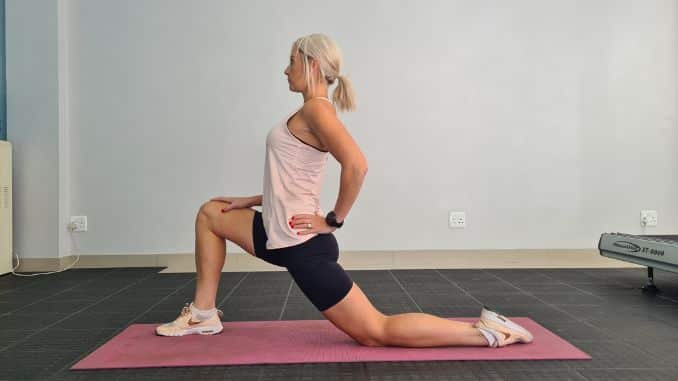
This is a must-do stretch if you spend long hours sitting!
- Begin in an upright standing position with your feet hip-width apart, maintaining good alignment with your head, shoulders, hips, and then legs.
- Step forward with one foot, position your front leg at a 90-degree angle, and kneel your back leg.
- Untuck your toes by placing the tops of your feet flat on the floor.
- Place your hands on your hips.
- Engage your core and move your hips forward while keeping your spine straight.
- Hold the position for several deep belly breaths, in through your nose and then out through your mouth.
- Relax and then repeat the movement on the opposite side.
Why it works: It loosens the iliopsoas muscles [4], reducing stress on the pelvic floor and then tailbone.
3. Figure 4 Stretch (Relieves Tension in the Glutes)

By loosening the gluteus maximus, this stretch helps with proper alignment and then tailbone pain relief.
- Lie on your back with your knees bent and then your feet flat on the floor.
- Cross one ankle over your opposite knee.
- Place your hands at the back of the knee and pull your knee closer to your chest.
- Hold this position for several deep belly breaths, in through your nose and then out through your mouth.
To intensify the stretch, you can also put your hands around your knee and pull your knee forward closer to your chest.
Why it works: Targets hip opening muscles and piriformis [3]—tightness here can worsen pain symptoms.
4. Piriformis Stretch (Targets the Deep Hip Muscles)
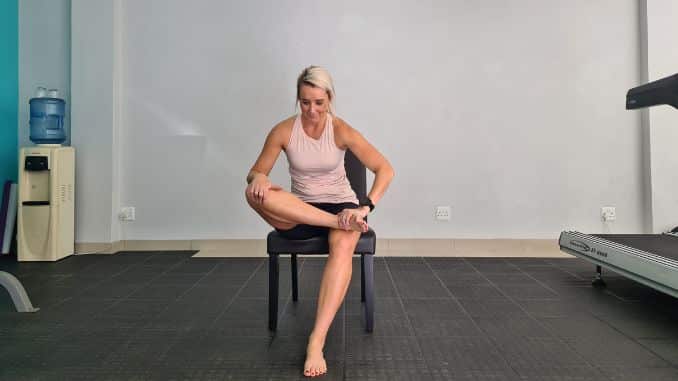
- Begin in an upright sitting position on a chair with your knees bent and then feet flat on the floor, maintaining good alignment in your upper body.
- Tighten your abdominal muscles.
- Shift your body weight to one side and cross your right foot over your left knee.
- Lean your upper body forward and then hold the position for several deep belly breaths.
- Relax and repeat the movement on the opposite side.
Why it works: It loosens the piriformis muscle, which connects to the tailbone and then can cause discomfort.
5. Cat-Cow Stretch (Spinal Mobility & Pain Relief)

This exercise is effective in relieving tailbone pain by improving spinal flexibility.
- Begin in a 4-point position with your hands beneath your shoulders and then your knees under your hips.
- Engage your core.
- Inhale, then slowly lift your head as you arch your mid-back.
- Exhale, then alternate by rounding out your mid back as you lower your head towards the floor.
- Repeat the movement, alternating directions. Start with 1 set of 5 repetitions.
Why it works: Stimulates blood flow, promotes flexibility, and then aligns the entire spine.
6. Pelvic Tilts (Strengthens Core & Improves Alignment)

This exercise strengthens muscles surrounding the tailbone, preventing persistent pain.
- Lie on your back with your knees bent and feet flat on the floor, maintaining good alignment with your head, shoulders, hips, and then legs.
- Place your hands at your side with palms pressed on the floor.
- Tighten your abdominal muscles.
- Squeeze and tilt your pelvic floor muscles in and tilt your pelvis down pressing your low back into the floor.
- Hold this position for several deep belly breaths, in through your nose and out through your mouth.
- Relax and return to the starting position.
Why it works: Engages abdominal muscles and the pelvic floor, which support the bottom of the spine.
7. Torso Lifts (Core Strengthening)
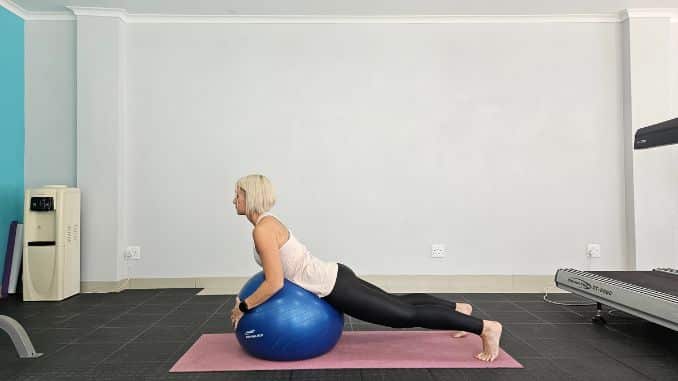
For this movement, you may utilize a stability ball.
- Begin in a kneeling position in front of a stability ball.
- Place your hands on the ball, with your chest gently resting on the ball.
- Straighten your legs and engage your core.
- Slowly lift your torso upward, arching your mid-back.
- Hold for a couple of seconds before relaxing. Repeat the movement 10–15 repetitions.
Why it works: It builds core strength, preventing poor posture that leads to persistent tailbone pain.
8. Single Leg Knee Hug (Loosens Tight Hips)
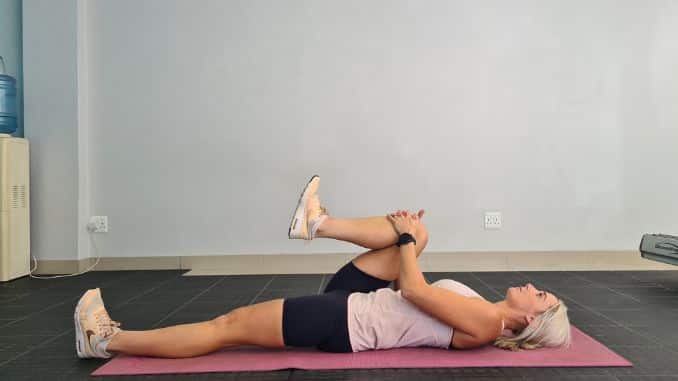
- Lie on your back on the floor with your legs straight, and then maintain good alignment with your head, shoulders, hips, and toes.
- Engage your core.
- Lift and bend one knee towards your chest and wrap your arms around the bent knee for support.
- Hold the position for several deep belly breaths, in through your nose and out through your mouth.
- Relax and then repeat the movement on the opposite side.
Why it works: It stretches hip flexors and then reduces muscle tension in the tailbone area.
9. Cobra Stretch (Strengthens the Lower Back & Opens the Chest)

This stretch also stimulates blood flow to the bottom of the spine, reducing muscle tension and then promoting pain relief.
- Lie on your stomach on the floor with your legs straight and feet shoulder-width apart, maintaining good alignment with your head, shoulders, hips, and then toes.
- Plant your hands at your sides at chest height.
- Contract your abdominal muscles and lift your mid-back upward using your arms as support.
- Hold this position for several deep belly breaths, in through your nose and out through your mouth.
- Relax and repeat the movement 3 repetitions.
Why it works: It helps relieve tailbone pain by stretching the entire spine and then promoting proper alignment
10. Reverse Kegels (Pelvic Floor Relaxation)
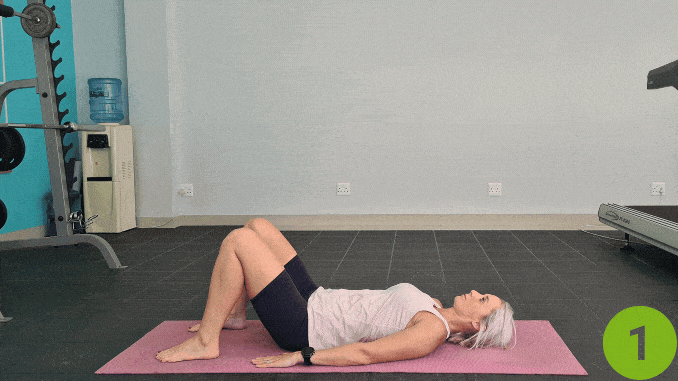
Tight pelvic floor muscles can worsen pain symptoms, so learning to relax them is key!
- Lie on your back with your knees bent and your feet flat on the floor, relaxing your upper body.
- Place your arms at your side.
- Contract your abdominal area, then push from your heels to lift your hips.
- Maintain good alignment with your head, shoulders, hips, and knees.
- Hold this position for several deep belly breaths, in through your nose and then out through your mouth.
- Relax and return to the starting position. Repeat the movement 10 repetitions.
Why it works: It relaxes pelvic floor muscles that may contribute to tailbone pain.
11. Foam Rolling Gluteus Maximus (Releases Tension in the Tailbone Muscles)
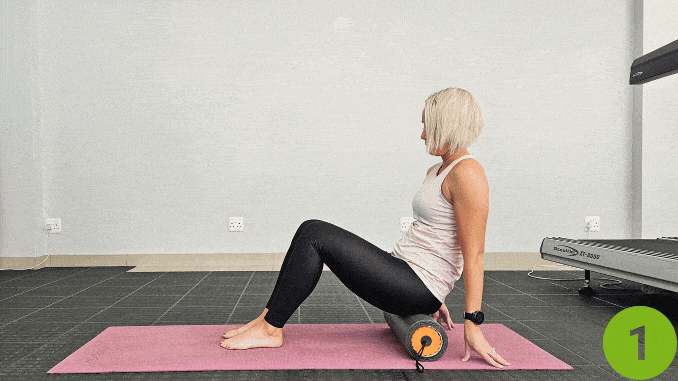
This technique stimulates blood flow, relieves tension, and then supports pain relief in the surrounding muscles of the tailbone.
- Begin in an upright sitting position on a foam roller with your knees bent and feet flat on the floor.
- Maintain good alignment with your head, shoulders, and hips.
- Place your hands at your side for support.
- Keep your abdominal muscles tight to ensure proper posture and then maximize the effectiveness of the exercise to engage the gluteus maximus.
- Extend one leg and lean slightly to one side, placing more weight on your glute muscles.
- Slowly roll back and forth for 30-60 seconds.
- Relax and repeat the movement on the opposite side.
If you are experiencing severe tailbone pain, start with gentler versions of these exercises. For instance, when doing the Cobra stretch, lift your torso just a few inches off the ground to avoid strain. Always listen to your body and then avoid pushing into pain.
It’s essential to note that while these exercises can help relieve tailbone pain, it’s crucial to consult with a healthcare professional before starting any new exercise program, especially if you have an underlying medical condition or injury.
Why it works: It helps release tight muscles in the glutes and lower back, which can contribute to persistent tailbone pain.
Causes of Tailbone Pain
There are several causes of tailbone pain, including:
- Injury or trauma: A fall or a direct blow to the tailbone can lead to significant pain and discomfort.
- Prolonged sitting: Sitting for long periods, especially on hard surfaces, can put excessive pressure on the tailbone.
- Poor posture: Slouching or improper alignment can strain the muscles and then ligaments around the tailbone.
- Degenerative disc or joint disease [2]: Conditions like arthritis can cause inflammation and then pain in the tailbone area.
- Infections: Osteomyelitis and other infections can lead to pain and inflammation in the tailbone.
- Tumors or cysts: These can exert pressure on the tailbone, resulting in pain.

Symptoms of Tailbone Pain
The symptoms of tailbone pain can vary depending on the underlying cause, but common symptoms include:
- Pain or discomfort in the tailbone area: This can range from a dull ache to sharp, severe pain.
- Pain when sitting, standing, or walking: Activities that put pressure on the tailbone can exacerbate the pain.
- Discomfort during bowel movements or sex: The tailbone’s proximity to the pelvic floor muscles can make these activities painful.
- Swelling or bruising: Visible signs of trauma or inflammation in the tailbone area.
- Limited mobility or stiffness: Difficulty moving or stiffness in the lower back and tailbone area.
Home Remedies for Tailbone Pain
Aside from exercises, here are several home remedies can relief help tailbone pain, including:
- Applying ice or heat: Use ice packs to reduce inflammation or heat pads to relax tight muscles.
- Over-the-counter pain relievers: Medications like ibuprofen or acetaminophen can help reduce pain and inflammation.
- Using a donut-shaped cushion: This can alleviate pressure on the tailbone when sitting.
- Practicing good posture: Maintaining proper alignment can reduce strain on the tailbone and then surrounding muscles.
- Engaging in gentle exercises: Stretching and strengthening exercises can improve mobility and reduce pain.
Incorporating these home remedies into your daily routine can provide significant relief from tailbone pain and improve your overall comfort.
Final Tips for Tailbone Pain Relief
- Avoid sitting too long—stand up and stretch every 20 minutes.
- Use a tailbone cushion to reduce pressure on the bottom of the spine.
- Massage the tailbone muscles to release tension.
- See a physical therapist for personalized guidance.
- Strengthen your core to support your spine.
- Maintain proper posture—keep your shoulders underneath your spine and avoid slouching.
Bill Gallagher, a physical therapist based in New York City, emphasizes the importance of a comprehensive approach to treating tailbone pain. He integrates manual therapy, prescriptive exercise, Yoga, Qigong, and Feldenkrais techniques to address the underlying causes of discomfort. This holistic method aims to alleviate pain and restore function effectively.
Conclusion: Take Control of Your Tailbone Pain
Tailbone pain can be frustrating, but with the right pain exercises, you can start feeling relief.
Gentle stretching, strengthening your core, and proper alignment all help relieve tailbone pain and prevent it from coming back.
Commit to doing these tailbone pain relief exercises daily, and you’ll soon notice less pain and more mobility.
If your pain persists, consider working with a physical therapist for additional support.
Relieve tension, improve flexibility, and boost recovery with these 10 Best Foam Rolling Moves for Your Entire Body! Whether you’re easing sore muscles or preventing injuries, these simple techniques will help you feel your best. Try them today and roll your way to better mobility!
FAQs
What is the fastest way to heal a hurt tailbone?
The fastest way to heal a hurt tailbone is to reduce pressure on it by using a donut cushion, applying ice packs, doing gentle stretches, and avoiding prolonged sitting. Anti-inflammatory medication and physical therapy can also speed up recovery.
How I cured my tailbone pain?
Most people relieve tailbone pain through a combination of gentle stretching exercises, posture correction, pelvic floor relaxation techniques, and using a tailbone cushion when sitting. In some cases, massage therapy or a physical therapist can help realign the coccyx for lasting relief.
Is massage good for tailbone pain?
Yes, massage can help relieve tailbone pain by reducing muscle tension around the pelvic floor and glutes. Deep tissue massage and trigger point release in the surrounding muscles can help alleviate pain and improve mobility.
How to adjust the tailbone at home?
You can try gentle stretching, pelvic tilts, and reverse Kegels to realign the tailbone. Avoid excessive pressure on the area, and if pain persists, a physical therapist or chiropractor may be needed for professional adjustment.
How long does a tailbone take to heal?
A bruised tailbone may heal in a few weeks, while a fractured or severely injured tailbone can take 6 to 12 weeks to fully recover. Doing tailbone pain relief exercises and avoiding prolonged sitting can speed up healing.

